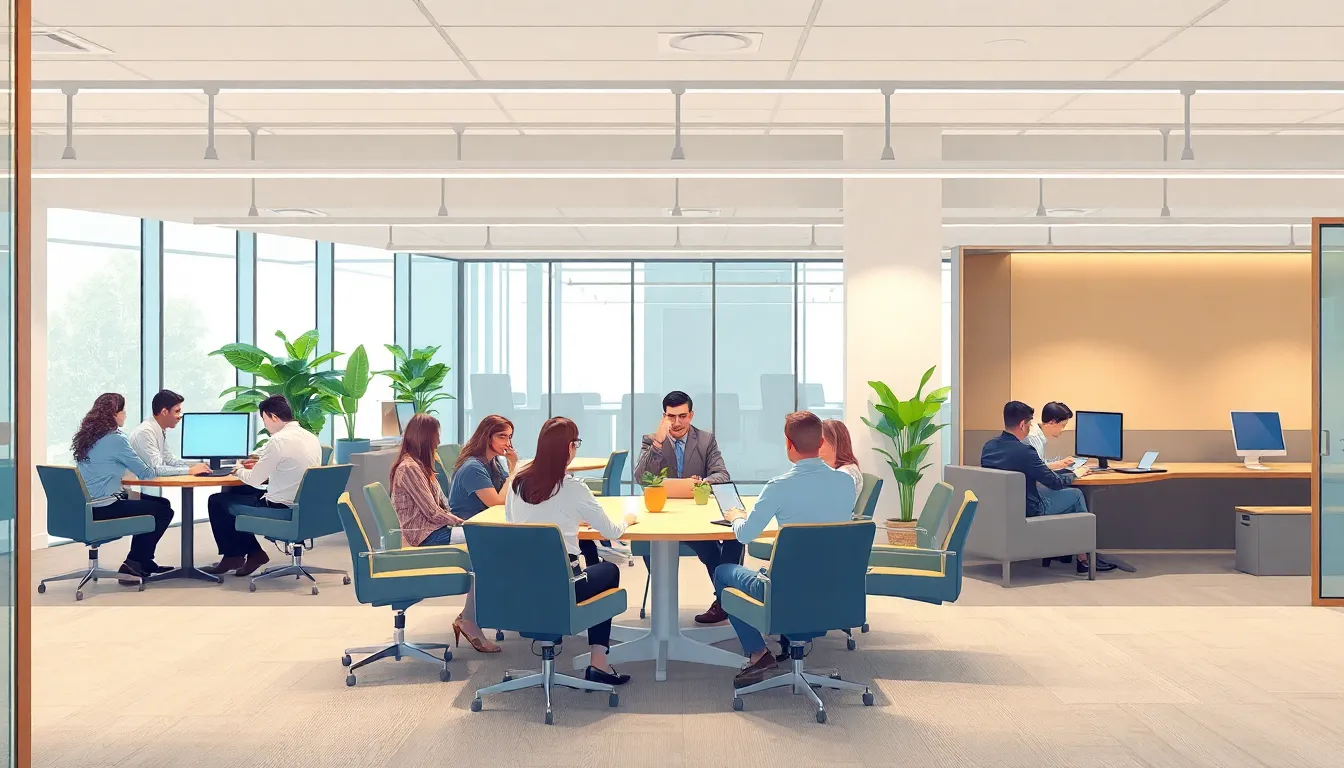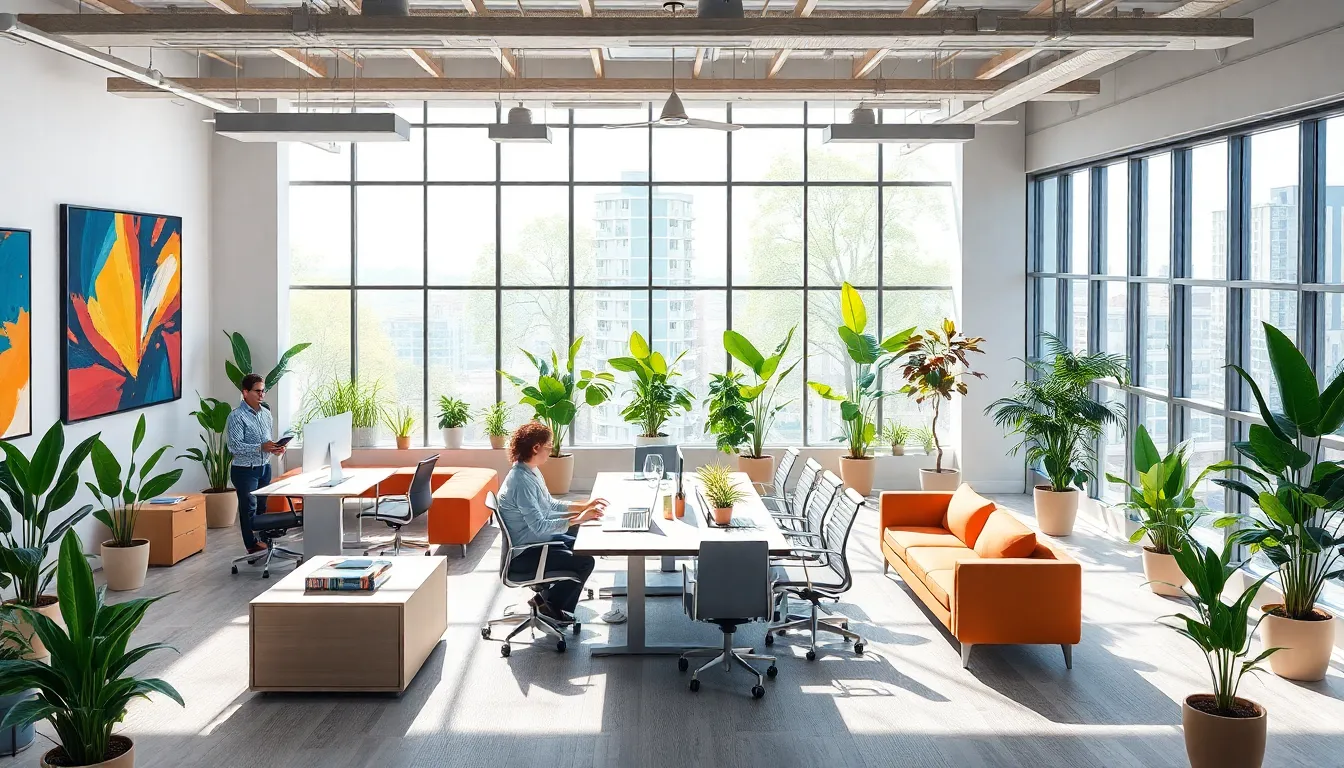In a world where the office is no longer just a cubicle farm, interior design plays a crucial role in boosting productivity and creativity. Imagine walking into a workspace that feels less like a stuffy boardroom and more like a cozy coffee shop—where every corner inspires brilliance. It’s time to ditch the drab décor and embrace designs that make employees excited to show up every day.
Table of Contents
ToggleCreative Interior Design Office Ideas
Incorporating vibrant colors can energize the workspace, sparking creativity. Consider using a color palette that reflects the brand’s identity while maintaining a lively atmosphere. Natural light plays a crucial role in improving mood and productivity. Positioning desks near windows maximizes sunlight exposure.
Flexible workspaces foster collaboration among employees. Implementing movable furniture allows teams to rearrange their environment to suit different tasks. Adding plants enhances air quality and promotes relaxation. Incorporating biophilic design creates a connection with nature and boosts overall well-being.
Art displays create a visually stimulating environment. Showcasing local artists or employee creations can inspire creativity and a sense of community. Ergonomic furniture is essential for comfort during long hours. Ensuring desks and chairs promote proper posture prevents discomfort and fatigue.
A cozy lounge area can serve as a retreat for quick breaks. Including soft furnishings such as couches and bean bags encourages informal interactions. Technology integration streamlines operations and enhances productivity. Equipping common areas with charging stations and smart boards improves collaboration.
Noise-reducing partitions are valuable in open-plan offices. They provide privacy and minimize distractions, making focus easier. Personalization opportunities allow employees to express their style. Encouraging the use of photos or inspirational quotes on desks cultivates a sense of ownership.
A well-designed kitchen area fosters social interactions. Providing a space for coffee breaks and lunches contributes to team bonding. Utilizing multi-purpose spaces ensures efficient use of the office layout. Areas designed for both relaxation and meetings can increase flexibility and serve diverse needs.
Modern Office Layouts

Modern office layouts focus on enhancing collaboration, creativity, and employee well-being. Designers emphasize flexibility and comfort, turning traditional spaces into functional environments that cater to various work styles.
Open-Concept Spaces
Open-concept spaces encourage interaction among team members. These layouts eliminate barriers, fostering a collaborative atmosphere. Enhanced communication often leads to increased creativity and problem-solving. Utilizing movable furniture supports adaptability in these settings. Organizations benefit by allowing employees to configure their work areas to suit specific tasks. Companies often incorporate communal tables, comfortable seating, and breakout areas to maintain engagement and promote socialization.
Private Nooks
Private nooks provide employees with quiet areas for focused work or personal reflection. These spaces often include soundproofed rooms or cozy corners that promote concentration. By incorporating elements like soft lighting and comfortable seating, companies create inviting retreats. Users gain the benefit of isolating themselves from distractions while still being part of an open environment. Flexible privacy options, such as movable partitions, allow for easily adapting these nooks based on daily needs. Overall, private nooks balance collaboration with the necessary solitude that boosts productivity.
Color Schemes and Palettes
Color schemes play a crucial role in setting the mood and enhancing productivity in office spaces. A well-chosen palette can inspire creativity and establish a welcoming environment.
Neutral Tones
Neutral tones create a calming backdrop that promotes focus and reduces distractions. Shades like beige, gray, and soft whites provide versatility, allowing for seamless furniture integration. Designers often favor these colors to foster a professional atmosphere. When paired with natural materials, neutral tones enhance the connection to the environment. Soft textiles in these shades also contribute to comfort, making workspaces more inviting. Overall, using neutral tones creates a foundation for an unobtrusive yet sophisticated office design.
Bold Accents
Bold accents add energy and visual interest to a workspace. Vibrant colors such as deep blues, rich greens, and energetic yellows serve as focal points, drawing attention to specific areas. These colors work particularly well on feature walls or in art displays. Incorporating bold accents can stimulate creativity and encourage collaboration among employees. Using colorful accessories like chairs, artwork, or decorative items allows for easy updates without a complete redesign. A strategic blend of bold elements with neutral tones creates a balanced and engaging office atmosphere.
Furniture Selection
Selecting the right furniture significantly influences office productivity and employee comfort. Opting for ergonomic and adaptable pieces ensures a workspace promotes both health and creativity.
Ergonomic Office Chairs
Ergonomic office chairs enhance comfort and support during long work hours. Adjustability features allow users to customize height, lumbar support, and armrest positioning for optimal posture. Choosing breathable materials keeps employees cool and comfortable, especially during busy days. Research shows that ergonomic chairs reduce fatigue and improve focus, leading to increased productivity. Investing in high-quality designs ensures durability, providing long-term benefits.
Multi-Functional Desks
Multi-functional desks offer versatility to accommodate various work styles and tasks. They facilitate transitions between sitting and standing, promoting movement throughout the day. Many modular desk options come with integrated storage solutions, helping keep the workspace organized and clutter-free. Collaborative features, like adjustable heights or communal surfaces, encourage teamwork. Selecting desks that align with the office’s design aesthetic enhances the overall look while meeting functional needs.
Incorporating Nature
Incorporating nature into office design boosts productivity and well-being. Natural elements create a calming atmosphere that enhances focus.
Biophilic Design Elements
Biophilic design elements improve the workplace by connecting occupants with nature. Open spaces with natural light influence mood and creativity positively. Incorporating materials like wood and stone reflects outdoor environments, creating a serene ambiance. Water features add soothing sounds, enhancing relaxation and reducing stress. Art inspired by nature further integrates this concept, making workspaces visually appealing.
Indoor Plants
Indoor plants contribute significantly to air quality and employee satisfaction. Varieties such as snake plants, pothos, and peace lilies thrive in low light and require minimal care. Incorporating greenery improves mood and reduces stress levels among employees. Positioning plants in common areas encourages interaction and enhances aesthetic appeal. Grouping plants together creates a dynamic and inviting environment, promoting collaboration. Integrating natural elements like plants fosters a healthier workplace.
Transforming office spaces through thoughtful interior design can significantly impact employee productivity and well-being. By incorporating vibrant colors natural light and biophilic elements companies can create environments that inspire creativity and collaboration.
Flexible workspaces ergonomic furniture and cozy lounge areas promote comfort and social interaction while private nooks provide essential quiet spaces for focused work. Emphasizing aesthetics through art displays and nature fosters a sense of community and ownership among employees.
Ultimately a well-designed office not only enhances the work experience but also reflects the company’s values and culture encouraging employees to thrive in their roles.






